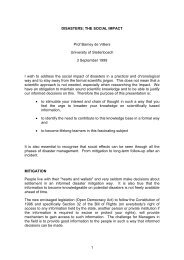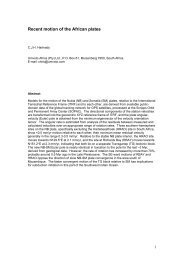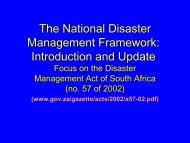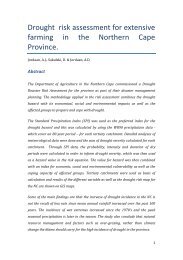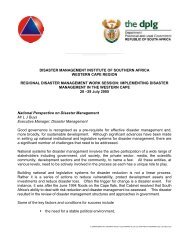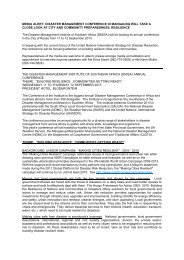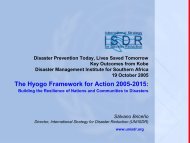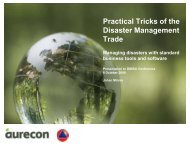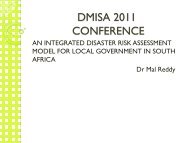BS Ngcamu, Dr. N Dorasamy - Disaster Management Institute South ...
BS Ngcamu, Dr. N Dorasamy - Disaster Management Institute South ...
BS Ngcamu, Dr. N Dorasamy - Disaster Management Institute South ...
- No tags were found...
Create successful ePaper yourself
Turn your PDF publications into a flip-book with our unique Google optimized e-Paper software.
The Fire and Emergency Services should design a course in Fire Fighting and Preventionspecifically to be implemented in the informal settlements. The trainees can thereafter be expectedto take back the skills and knowledge gained and educates residents in the informal settlements. Thetrainees can also assist the fire brigade, as they would have a good understanding of the proceduresand protocols for fire fighting.CONCLUSIONIt is obvious from this research that the informal settler’s decision to occupy disaster-pronesettlements is influenced by a lack of alternative opportunities, scarce resources, the need to gainaccess to employment, and short-term horizons. However, the majority proceed to stay in veryunsafe conditions without the municipality’s disaster preparedness strategies. There is poorattention paid to shack dwellers given to the benefits of keeping them in the same location after adisaster, by providing the appropriate infrastructure to reduce vulnerability in future. The planningpolicies and practices fail to solve informal settlements that are susceptible to fires without anywarning systems in place. Appropriate formal houses with sturdy building materials should be builtwith the aim of eliminating the mushrooming of informal settlements to open spaces. Therefore,future research could profitably overcome the aforementioned challenges by looking at other factorssuch as public involvement in preparedness planning, Geographical Information Systems (GIS)applications, legal liability and intergovernmental tensions to disaster management. GIS should beused mainly for hazard identification and mapping and houses built should comply with urbanplanning by-laws. The municipalities should promote integrated and coordinated disastermanagement through partnerships between different stakeholders and through cooperative relationsbetween all spheres of government.REFERENCESAlexander, D. 2002b. “From civil defence to civil protection – and back again”, <strong>Disaster</strong>Prevention and <strong>Management</strong>, 1(3): 209-13.Allen, K. 2006. Building Community Resilience to <strong>Disaster</strong> in the Philippines’, in InternationalFederation of Red Cross and Red Crescent Societies (ed). World <strong>Disaster</strong> Report: Focus onCommunity Resilience, Geneva: International Federation of Red Cross and Red CrescentSocieties.Armstrong, E. 2005. Integrity, Transparency and Accountability in Public Administration: RecentTrends, Regional and International Developments and Emerging Issues, United Nations.Blanco, A. V. R. 2006. Local initiatives and adaptation to climate change. <strong>Disaster</strong>s, 30(1): 140-24



